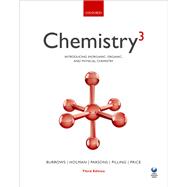Chemistry is widely considered to be the central science: it encompasses concepts on which all other branches of science are developed. Yet, for many students entering college, gaining a firm grounding in chemistry is a real challenge. Chemistry3 responds to this challenge, providing students with a full understanding of the fundamental principles of chemistry on which to build later studies.
Unique among the introductory chemistry texts currently available, Chemistry3 is written by a team of chemists to give equal coverage of organic, inorganic and physical chemistry - coverage that is uniformly authoritative. The approach to organic chemistry is mechanistic, rather than the old-fashioned 'functional group' approach, to help students achieve a fuller understanding of the underlying principles.
The expertise of the author team is completed by two specialists in chemistry education, who bring to the book a wealth of experience of teaching chemistry in a way that students enjoy and understand. The result is a text that builds on what students know already from school and tackles their misunderstandings and misconceptions, thereby providing a seamless transition from school to undergraduate study.
The authors achieve unrivalled accessibility through the provision of carefully-worded explanations and reminders of students' existing knowledge; the introduction of concepts in a logical and progressive manner; and the use of annotated diagrams and step-by-step worked examples. Students are encouraged to engage with the text and appreciate the central role that chemistry plays in our lives through the unique use of real-world context and photographs.
Chemistry3 tackles head-on two issues pervading chemistry education: the students' mathematical skills, and their ability to see the subject as a single, unified discipline. Instead of avoiding math, Chemistry3 provides structured support, in the form of careful explanations, reminders of key mathematical concepts, step-by-step calculations in worked examples, and a Math Toolkit, to help students get to grips with the essential mathematical element of chemistry. Frequent cross-references highlight the connections between each strand of chemistry and explain the relationship between the topics, so students can develop an understanding of the subject as a whole.








